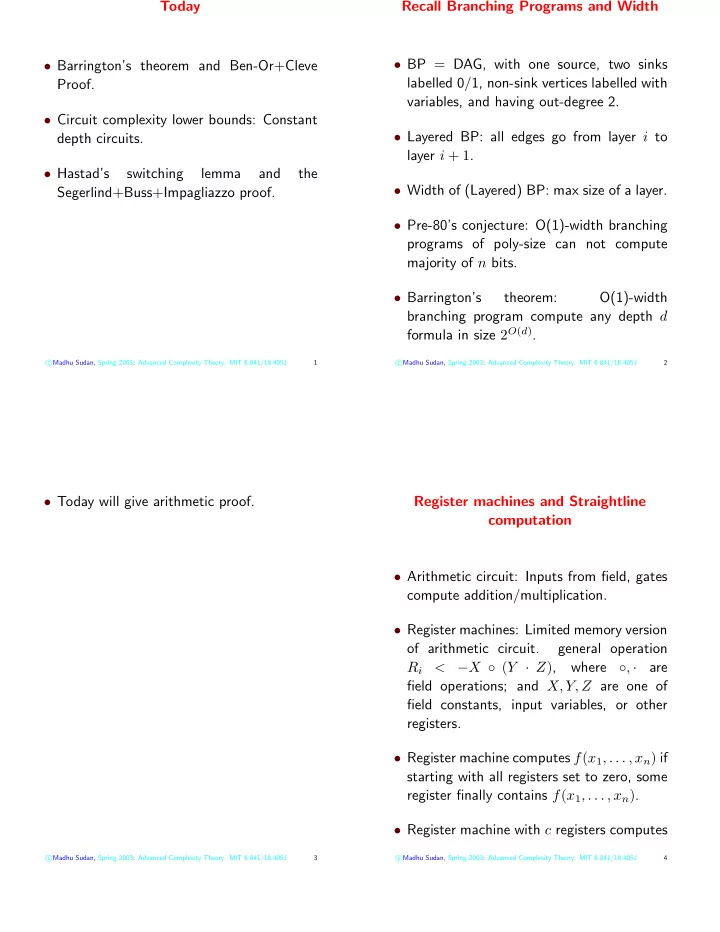

Today Recall Branching Programs and Width • BP = DAG, with one source, two sinks • Barrington’s theorem and Ben-Or+Cleve labelled 0/1, non-sink vertices labelled with Proof. variables, and having out-degree 2. • Circuit complexity lower bounds: Constant • Layered BP: all edges go from layer i to depth circuits. layer i + 1 . • Hastad’s switching lemma and the • Width of (Layered) BP: max size of a layer. Segerlind+Buss+Impagliazzo proof. • Pre-80’s conjecture: O(1)-width branching programs of poly-size can not compute majority of n bits. • Barrington’s theorem: O(1)-width branching program compute any depth d formula in size 2 O ( d ) . � Madhu Sudan, Spring 2003: Advanced Complexity Theory: MIT 6.841/18.405J c 1 � Madhu Sudan, Spring 2003: Advanced Complexity Theory: MIT 6.841/18.405J c 2 • Today will give arithmetic proof. Register machines and Straightline computation • Arithmetic circuit: Inputs from field, gates compute addition/multiplication. • Register machines: Limited memory version of arithmetic circuit. general operation R i < − X ◦ ( Y · Z ) , where ◦ , · are field operations; and X, Y, Z are one of field constants, input variables, or other registers. • Register machine computes f ( x 1 , . . . , x n ) if starting with all registers set to zero, some register finally contains f ( x 1 , . . . , x n ) . • Register machine with c registers computes � Madhu Sudan, Spring 2003: Advanced Complexity Theory: MIT 6.841/18.405J c 3 � Madhu Sudan, Spring 2003: Advanced Complexity Theory: MIT 6.841/18.405J c 4
f over F 2 , then f can be computed with Ben-Or+Cleve Theorem width 2 c . • If f can be computed by depth d arithmetic formula, then f can be computed by 3- register machine with length 2 O ( d ) . • Implies width eight braching program for all poly-sized formulae. � Madhu Sudan, Spring 2003: Advanced Complexity Theory: MIT 6.841/18.405J c 5 � Madhu Sudan, Spring 2003: Advanced Complexity Theory: MIT 6.841/18.405J c 6 Proof Summary on branching programs • Inductive claim: If f has depth d , • Major open questions: and R 1 , R 2 , R 3 are arbitrarily initialized, − Are O (1) -width poly-sized branching then can leave register machine in state programs equal to unbounded width poly- ( R 1 , R 2 , R 3 + f ( x 1 , . . . , x n ) · R 2 in length 2 2 · d . sized branching programs? − Give ”explicit” function with super-poly • Base Case trivial. branching program size. • Induction: If f = f 1 + f 2 , then draw picture. • Till date no success except by limiting width/length. • Induction: If f = f 1 ∗ f 2 , then draw complex picture. • Till recently, no technique for even super- linear depth. Recent progress: There exists • Verify lengths. an explicit function that takes super-linear depth, if size is 2 ǫn . [Ajtai]. � Madhu Sudan, Spring 2003: Advanced Complexity Theory: MIT 6.841/18.405J c 7 � Madhu Sudan, Spring 2003: Advanced Complexity Theory: MIT 6.841/18.405J c 8
• Won’t cover this result; but will encounter Circuit complexity a uniform version with simple proof. • Most general model of non-uniform computing. • Not suprisingly little known for unrestricted case. • Restricted cases: − Monotone circuits: Exponential lower bounds known. − Bounded depth, unbounded fan-in OR/AND (known as AC 0 ): exponential lower bounds known. • In these lectures: − Combinatorial proof of AC 0 lower bound. � Madhu Sudan, Spring 2003: Advanced Complexity Theory: MIT 6.841/18.405J c 9 � Madhu Sudan, Spring 2003: Advanced Complexity Theory: MIT 6.841/18.405J c 10 − Algebraic proof of AC 0 lower bound. AC 0 lower bounds for parity − Connections between circuit depth and communication complexity. Defn: � ( x 1 , . . . , x n ) = � n i =1 x i ( mod 2) . Theorem: Parity of n bits requires exponential size for O (1) depth circuits. • First super polynomial bounds established by Furst, Saxe and Sipser and independently by Ajtai. • Exponential bounds given later by Yao. • Hastad gave a clean exponential lower bound, highlighting the role of the switching lemma. • Razborov-Smolensky later gave an algebraic proof. � Madhu Sudan, Spring 2003: Advanced Complexity Theory: MIT 6.841/18.405J c 11 � Madhu Sudan, Spring 2003: Advanced Complexity Theory: MIT 6.841/18.405J c 12
Switching lemma k -DNF is an OR of terms, where each term is AND of at most k literals. k -CNF is an AND of clauses, where each clause is the OR of at most k literals. Random restriction with parameter p : Set each variable to 0 / 1 w.p. (1 − p ) / 2 each and leaves it unset with probability p . Does this independently for each variable. Hastad’s Switching lemma: Random restriction of k -CNF with parameter p ≤ 1 / 7 yields a ℓ -DNF with probability at least 1 − (7 pk ) ℓ . � Madhu Sudan, Spring 2003: Advanced Complexity Theory: MIT 6.841/18.405J c 13
Recommend
More recommend